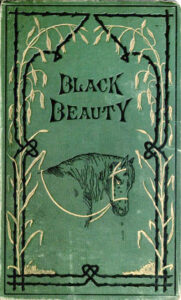I recently had a very pleasant short holiday in Bath, a city I hadn’t visited for some time. One of the things I learned while there is that Anna Sewell (1820-1878) lived in Bath for a while with her parents from 1860. And that reminded me that it’s many years since I read her very famous (and only) novel, Black Beauty, so I have now revisited it. And first surprising thing is that, although it’s been marketed and perceived as a childrens’s novel since its publication nearly 150 years ago in 1877, she intended it for adults.
In case you’ve grown up on a different planet let me remind me that it’s a first person narrative by a horse who’s sold and resold several times, which Sewell uses as a vehicle to promote animal welfare – this, bearing in mind that, when all road transport was dependent on horses, welfare issues weren’t necessarily top of the agenda for most people. What fun it is, incidentally, to reflect in the 21st century that we still measure vehicle capability in “horsepower.”

What, as a mature adult, I liked about Black Beauty is that it isn’t anthropomorphic. Black Beauty and the other horses he is associated with can talk to each other. And they understand what human beings are saying although they cannot speak to them. Apart from these devices to allow the story to be told, Sewell’s horses are horses through and through. They eat grain and love apples. They sweat and get ill if they’re not rubbed down. They adore meadows and hate dark stables. They swish off flies. Their knees are vulnerable. When they can no longer work they will be shot and sent “to the dogs”. And I suppose they mate – or are gelded – but this is Victorian England so she never mentions it.
Sewell’s purpose is to raise awareness of horse needs and feelings. I was never a horsey child and this was where I first learned about the cruelty of the check rain – the habit of strapping a horse’s head at an unnaturally high angle for reasons of fashion. It is desperately uncomfortable for the horse and makes it difficult to exert the power required, for example, to drag a heavy load uphill. Humane drivers and grooms will give a horse its head. And there’s the origin of yet another everyday expression. I suppose it’s inevitable that so many of our idioms are horse-related. People used horses for thousands of years. We’ve had mechanised road transport for barely 125 years.

“Flogging a dead horse” is another. Sewell is moving on the use of the whip. Through her equine narrator, she asserts that it should rarely be necessary and then – if the driver is competent and the animal complaint because it’s never been ill-treated – only a brush across the horse’s back. A well-treated horse, we learn, almost always knows what its driver or rider needs. And we see Black Beauty in a whole range of working situations: mount for a lady in a big house, carriage horse, cab horse, haulier’s horse, pulling a hearse and a lot more. And other horses tell him about their experience elsewhere – in the hunt, for instance. In the end, with narrative neatness, he comes more or less back to where he started and the novel ends quite hopefully. It certainly drives home the message that horses were a key part of almost every aspect of everyday life in 1877.
Sewell’s message doesn’t stop with horses either. She also brings in a pitiful litter of puppies whose ears have been cruelly mutilated (“cropped”) for no reason other than fashion. She presents them in pain and bleeding and it’s quite distressing.
I do like the way though that Beauty and his fellow horses have some nasty experiences but also some very good ones. Many people are kind, decent and good at we’d now call “empathy” with animals. Her point of view is balanced and reasonable. And it was very innovative at the time to take an animal as your post of observation.

Poor Anna Sewell’s life was beset by illness. She had a serious accident in childhood which affected her for a long time. In adult life she was ill – and bed-ridden – for many years before her early death at age 58, probably from tuberculosis but maybe hepatitis – or both. She lived only five months after the publication of Black Beauty but it was an instant success so presumably she died secure in the knowledge that she had achieved something worthwhile. I hope so.
Next week on Susan’s Bookshelves: Mozart in Italy by Jane Glover